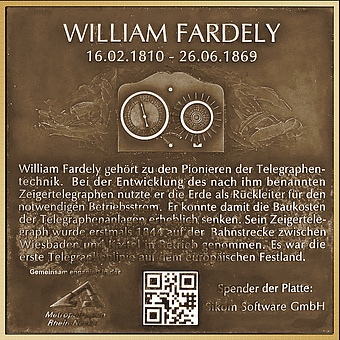1844 Pointer telegraph
William Fardely (16.02.1810 - 26.06.1869)
William Fardely was one of the pioneers of telegraph technology. In developing the pointer telegraph named after him, he used the earth as a return conductor for the necessary operating current. He was thus able to significantly reduce the construction costs of telegraph systems. His pointer telegraph was first put into operation in 1844 on the railroad line between Wiesbaden and Kastel. It was the first telegraph line on the European mainland.
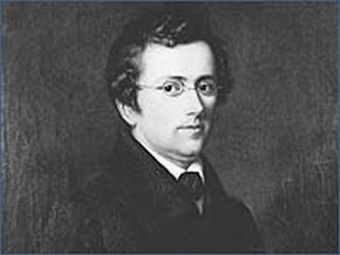
William Fardely was born on February 16, 1810, in Ripon, a small town in the English county of Yorkshire, the son of a wealthy Englishman and a German mother.
A few years after William's birth, the family moved to Koblenz, his mother's hometown, but moved to Mannheim in October 1820.
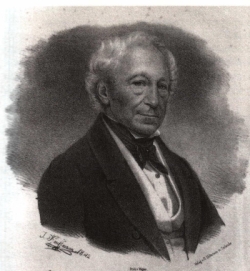
There, the Baden politician Johann Adam von Itzstein, a brother-in-law of William's mother, works as a court court councillor.
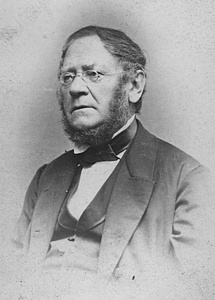
We know little about Fardely's education. However, he probably owes his excellent scientific knowledge to the physicist Wilhelm Eisenlohr, the husband of his cousin, Gertrud von Itzstein. Wilhelm Eisenlohr taught physics and mathematics at the Grand Ducal Lyceum in Mannheim at the age of 19 and published a widely read textbook on physics in 1836. In 1840, Eisenlohr took over the physics professorship at the Polytechnic School in Karlsruhe.
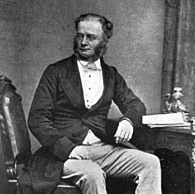
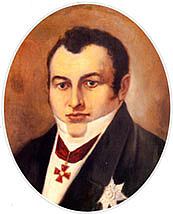
Together with the young physician William Cooke, Fardely attended a lecture at the University of Heidelberg in 1836, where a telegraph apparatus built by Paul Ludwig Schilling von Cannstatt was demonstrated.
Cooke was so impressed by it that he began to build a telegraph himself while still in Germany.
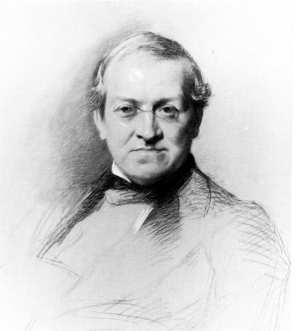
When he returned to England, he developed two more telegraphs together with Charles Wheatstone, an instrument maker and later professor of physics at King's College in London. In one of them, the letters of the telegrams are displayed by an electromagnetically operated pointer.
In 1840, Fardely travels to England to join Cooke, and during his two-year stay he is intensively involved in the construction and use of telegraphs. In 1842, Fardely returned to Mannheim. He now calls himself a telegraph engineer and publishes a paper on "galvanic electricity".
In May 1843, he gave a lecture on electromagnetic telegraphs to the members of the newly founded trade association, of which he was a member of the board, and presented the pointer telegraph he had developed.
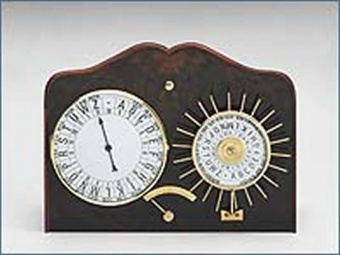
A transmitter and a receiver are installed side by side in a housing. By transmitting the electrical pulses generated in the transmitter, an electromagnet is triggered in the receiver of the remote station, which stops a hand rotating across the dial inscribed with letters and numbers at the desired position. How far the pointer is moved depends on the number of current pulses transmitted.
When the first railroads went into operation in England in 1825 and in Germany ten years later, there were still no signals. It was not until 1837 that the first telegraph line went into operation in England. The first trains began running on the Taunusbahn line between Frankfurt and Wiesbaden in 1840. For their safety, there is only a signal system with bells. Fardely is able to convince those responsible at the Taunusbahn to set up a telegraph line with his equipment on the 8.8 km line between Kastel and Wiesbaden. It is the first electric telegraph line for railroad operation on the European mainland.
In doing so, Fardely is the first in Europe to use the earth as a return conductor for the operating current, thus saving a line and significantly reducing material and manufacturing costs. Fardely uses a 1.5 mm diameter copper wire as the conductor and attaches it to wooden poles. To improve contact with the ground, copper plates are buried in the ground at the end points of the line. Laying the line wire above ground has another advantage besides lower cost. A transportable legraph can be connected at any point along the line so that messages can be sent and received even when the line is in the open. Fardely had the apparatuses manufactured in large numbers and thus at low cost by a Black Forest clock manufacturer.
Since the pointer telegraphs and their installation are inexpensive and easy to operate after only brief instruction, they are soon introduced on other railroad lines: in 1846/47 on the Saxon-Silesian and Saxon-Bavarian railroads. In 1851, the telegraph line along the Palatine Ludwigsbahn between Neunkirchen and Ludwigshafen is equipped with his pointer telegraphs under Fardely's direction. They remain in operation beyond his death.
However, Fardely did not enjoy any further success. After 1851, his pointer telegraphs are no longer installed. As early as 1847, the newly founded company Siemens & Halske began to manufacture under license so-called "Morse telegraphs" according to the method already introduced by Samuel Morse in the United States in 1837. They are not only characterized by considerably higher transmission speeds, but also offer the advantage that the transmitted text is preserved on a paper strip. However, the personnel must be specially trained. Soon, the "Morse telegraph recorders" are considered to be the technically superior devices, displacing the pointer telegraphs.
Fardely first tried to develop the pointer telegraph into a printing telegraph, but was unsuccessful. His work on developing relay transmission and improving galvanic elements was also ultimately unsuccessful. In 1856, Fardely also worked as a pyrotechnician and as a musician and painter. In the last years of his life, he lived in seclusion in the Saam House in what is now Schwetzinger Strasse and occupied himself with scientific studies.
William Fardely died on June 26, 1869 in the General Hospital in Mannheim. Today, hardly any traces of the once famous man can be found. His few surviving pointer telegraphs and most of his writings fall victim to the Second World War in the Schlossmuseum.
Siemens pointer telegraph
Plate
Location: Plate #12 in front of the Mannheim Castle
Sponsor: Sikom Software GmbH
Places in the Kurpfalz
former residential building in D6, 9-11 Mannheim
Links
https://de.wikipedia.org/wiki/William_Fardely
http://sammlung.ient.rwth-aachen.de/de/katalog/elektrische-telegrafie/siemens-zeigertelegraf.html


